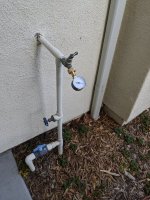Let's assume I'm going to need a pressure reducing valve (PRV) installed. (I'm going to turn off my water heater this evening to be absolutely certain the overnight pressure spikes are externally generated.)
Recommendations on PRV brands/features welcome. On the Home Depot website, I see mostly Watts and Zurn products, mostly brass.
Recommendations also welcome on installation. I've attached a picture of how water enters my home--the vertical pipe is the water supply line, coming up out of the ground. The junction is for backyard irrigation. Above that is the shutoff. And above that is a hose spigot, with a pressure gauge attached (showing my usual 53-58 PSI daytime pressure). From there, the line goes into the wall of the garage and from there through an accessible but very tight attic space above the garage and into the house.
As best I can tell, there's no logical place for a PRV inside, e.g. crawling up into that space above the garage is extremely tight quarters, and there's no other place where the water supply line is exposed. Plus if I want to protect the irrigation system from excess pressure, the PRV would need to be outside.
I'm not sure how much trouble it would be to excavate a little and put the PRV, and maybe also house shutoff, and maybe also irrigation shutoff (should the order of those be reversed?), into a valve box. That would certainly be prettier, but might lead the plumber to be grumpy/charge me more.
Advice welcome! All the feedback has been super helpful so far, much appreciated.

